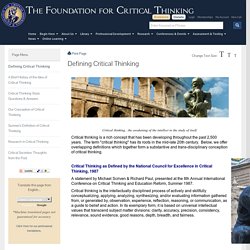

USHistoryNMH - Blog. Beyond the Five-Paragraph Essay - National Writing Project. Eric foner on american freedom. The Declaration of Independence: "An Expression of the American Mind" Activity 1.

The Declaration's Origins: Four (4) Primary Sources for Understanding the Declaration of Independence Much of the language and many of the ideas in the Declaration can be found in other documents, to which Jefferson and the other writers had access. In this activity, students will be able to see these influences and understand the evolution of ideas over time that culminated in the Declaration. (At this point, the teacher may want to show students the Maier interview or explain her view of the ideological underpinnings of the Declaration.)
Either working individually or in small groups, students will receive a copy the Declaration of Independence (to be annotated), copies of these four documents, and a chart to record information.As students read each of the four documents, they will search for the portion of the Declaration that was influenced by the document's text. 1. 2. 3. 4. Activity 2. 1. 2. Teacher Annotation in a separate PDF. 3. 4. 5. 6. Instructor's Manual. Abraham Lincoln-Related Curriculum and Lesson Plans. The History Place. Teacher Resources. The Library of Congress offers classroom materials and professional development to help teachers effectively use primary sources from the Library's vast digital collections in their teaching.

Find Library of Congress lesson plans and more that meet Common Core standards, state content standards, and the standards of national organizations. Discover and discuss ways to bring the power of Library of Congress primary sources into the classroom. Go to the blog Subscribe to the blog via e-mail or RSS. Using Primary Sources Discover quick and easy ways to begin using primary sources in your classroom, with teachers' guides, information on citing sources and copyright, and the Library's primary source analysis tool.
TPS Partners The Teaching with Primary Sources Program builds partnerships with educational organizations to support effective instruction using primary sources. The Teaching with Primary Sources Journal. Primary Sources from the National Humanities Center. The Best of the Humanities on the Web. U.S. History Sourcebook - Advanced. Search for - history - among resources. Facing History and Ourselves. RealClearPolitics - Opinion, News, Analysis, Videos and Polls. Infographics & Data Visualizations. Multimedia Educational Resource for Learning and Online Teaching.
Zotero. Critical Thinking Home Page. Defining Critical Thinking. It entails the examination of those structures or elements of thought implicit in all reasoning: purpose, problem, or question-at-issue; assumptions; concepts; empirical grounding; reasoning leading to conclusions; implications and consequences; objections from alternative viewpoints; and frame of reference.

Critical thinking — in being responsive to variable subject matter, issues, and purposes — is incorporated in a family of interwoven modes of thinking, among them: scientific thinking, mathematical thinking, historical thinking, anthropological thinking, economic thinking, moral thinking, and philosophical thinking. Critical thinking can be seen as having two components: 1) a set of information and belief generating and processing skills, and 2) the habit, based on intellectual commitment, of using those skills to guide behavior. Critical thinking varies according to the motivation underlying it. Another Brief Conceptualization of Critical Thinking ~ Linda Elder, September, 2007. Critical Thinking Index Page. TRC Writing Project Grid. Teachinghistory.org. Dave Eggers' wish: Once Upon a School.
Thousands of Free Lesson Plans and Educational Resources for Teachers. Opinion, News, Analysis, Videos and Polls. Stanford History Education Group.